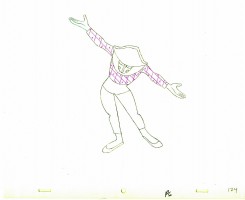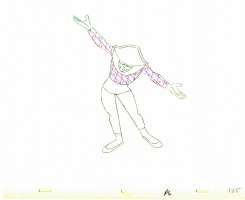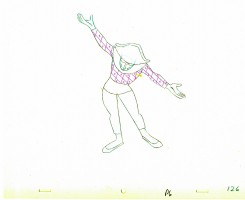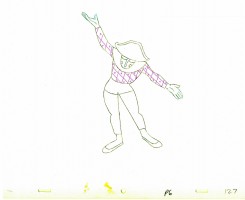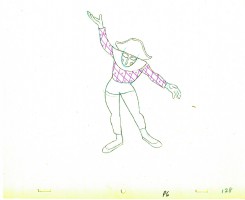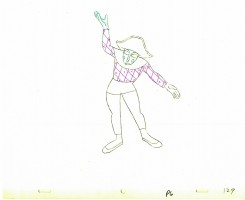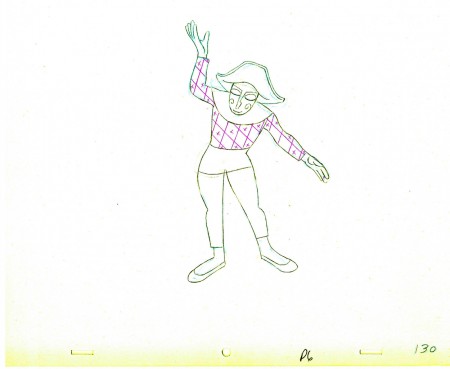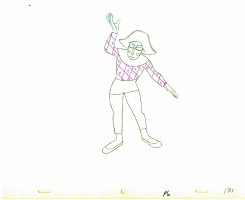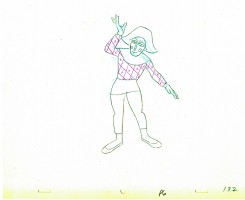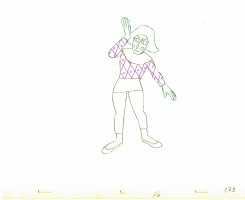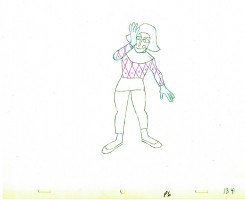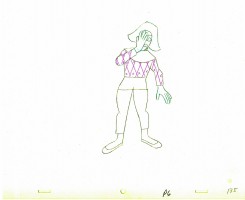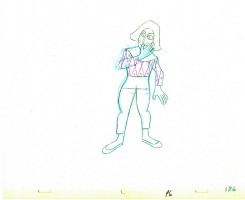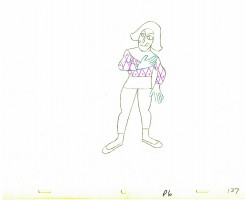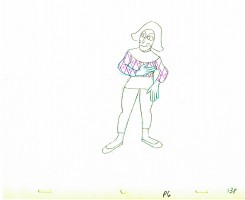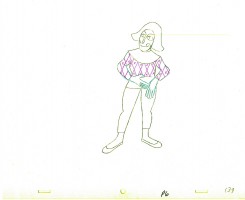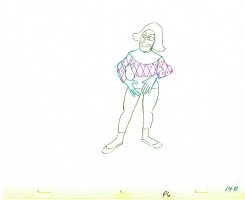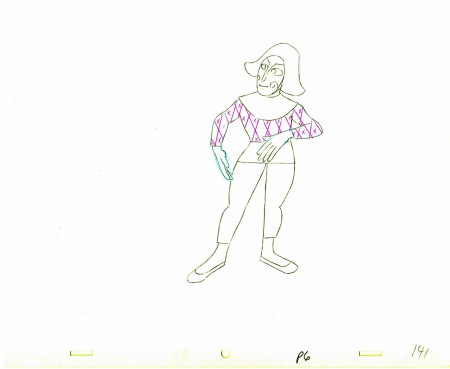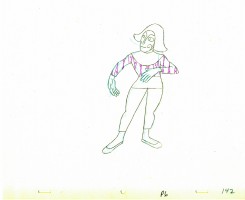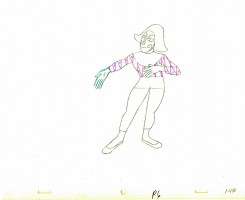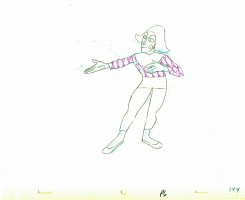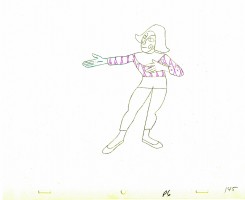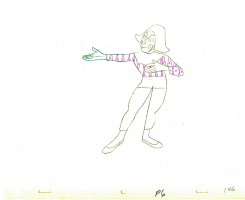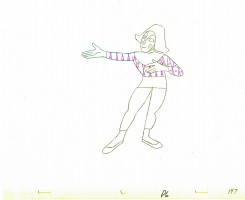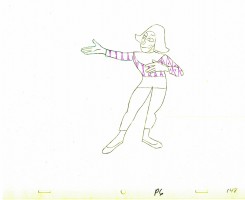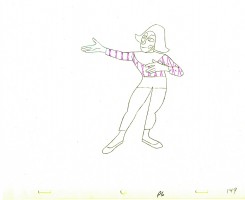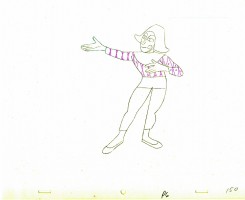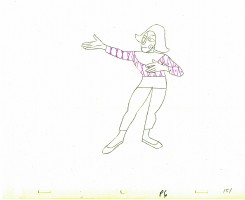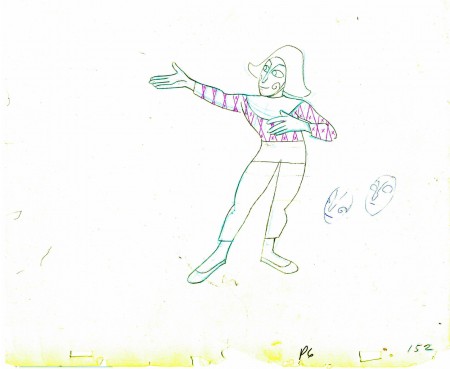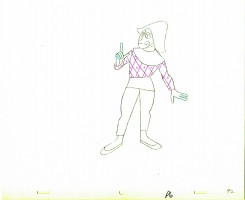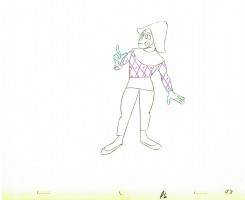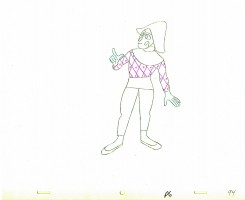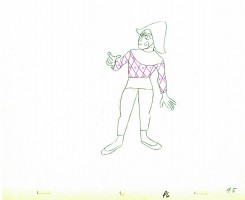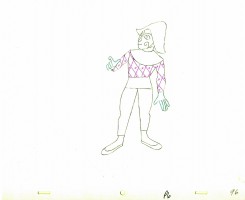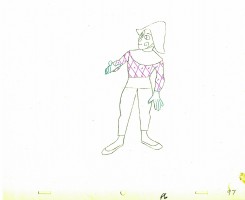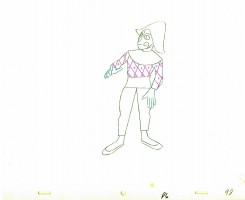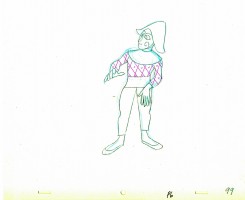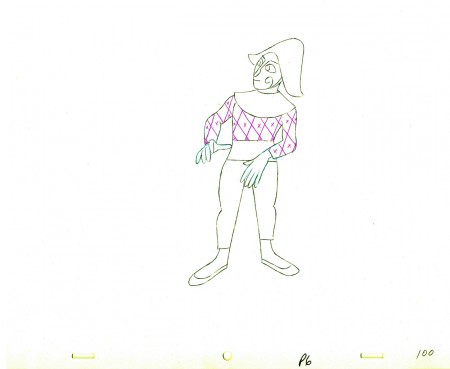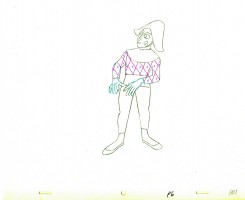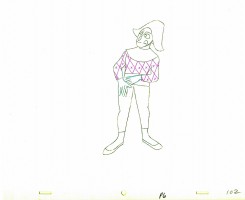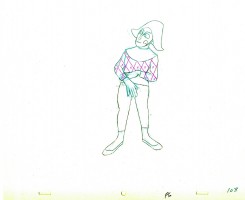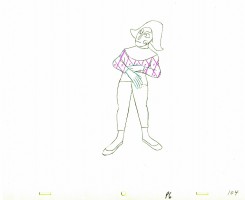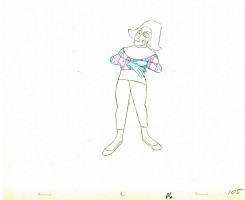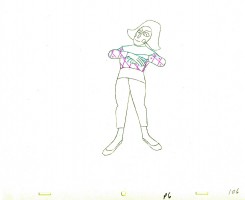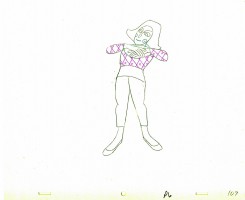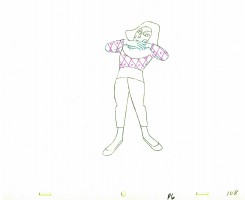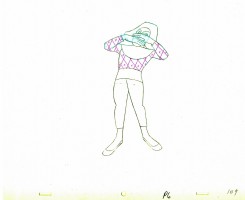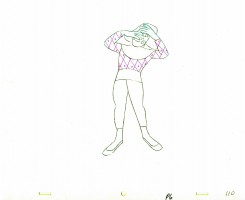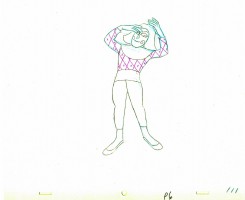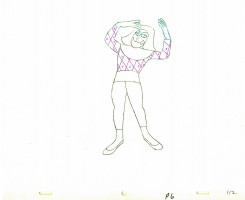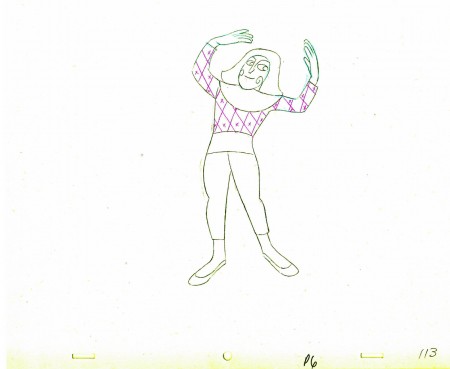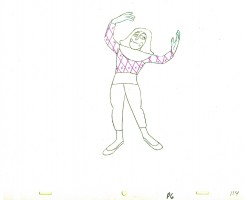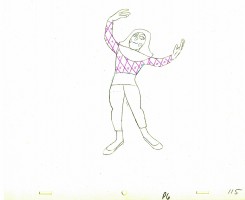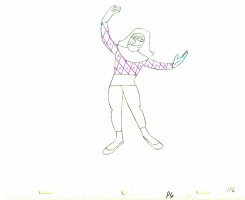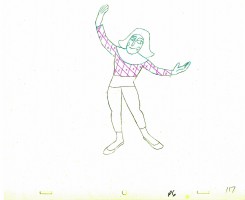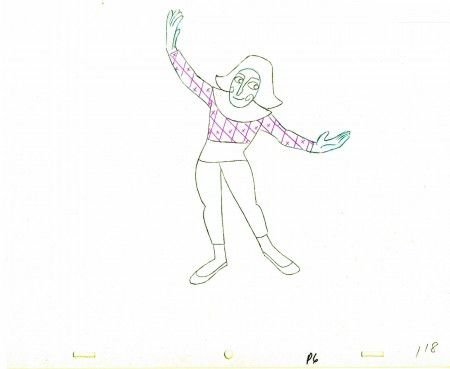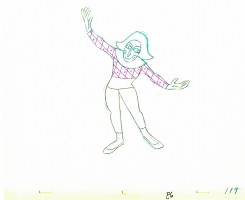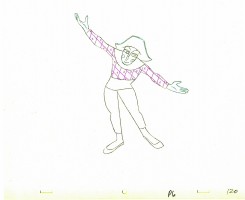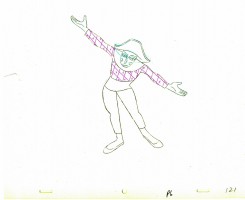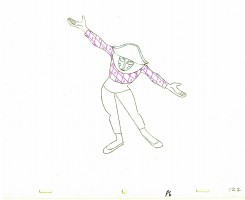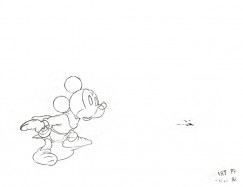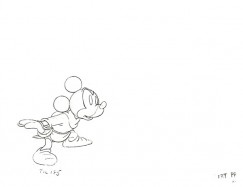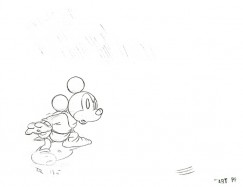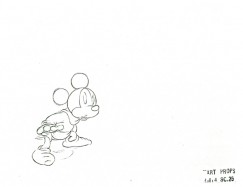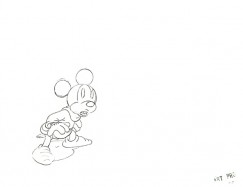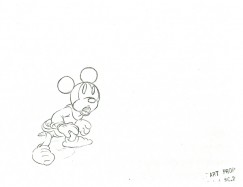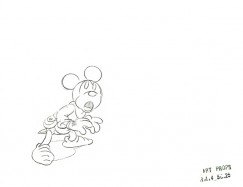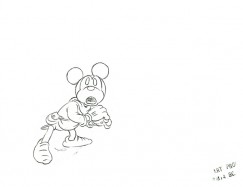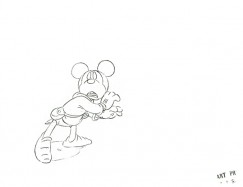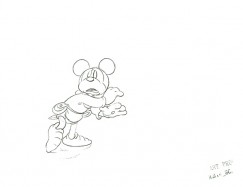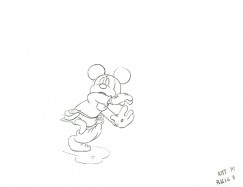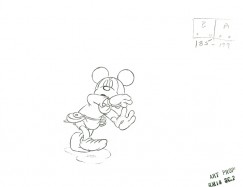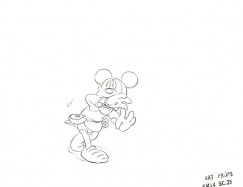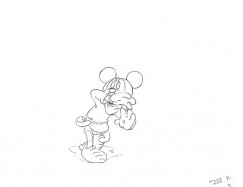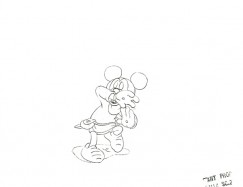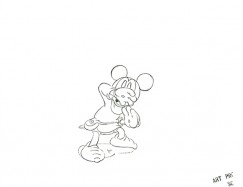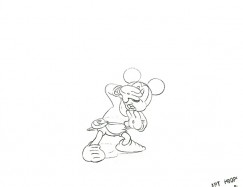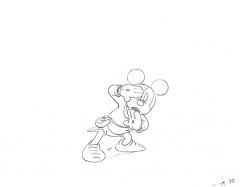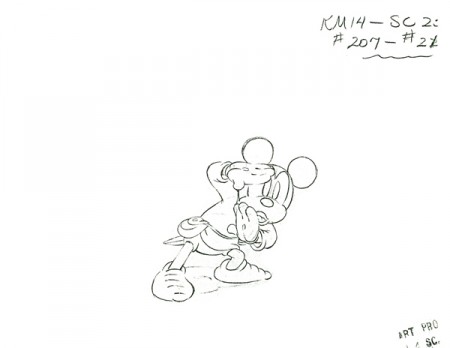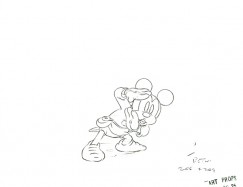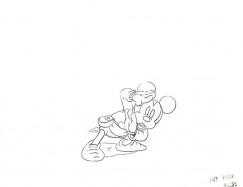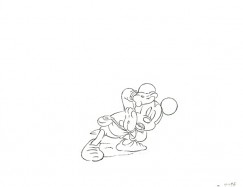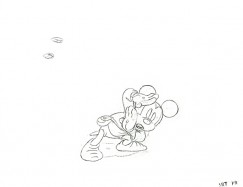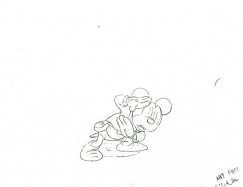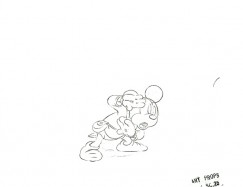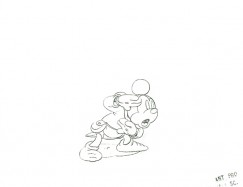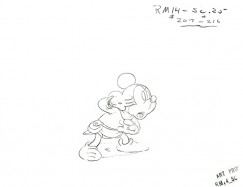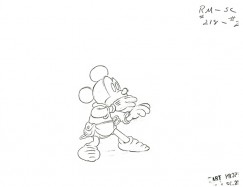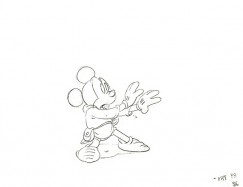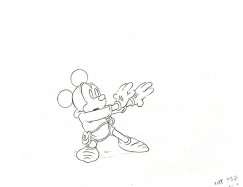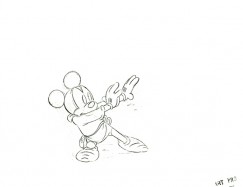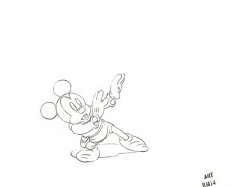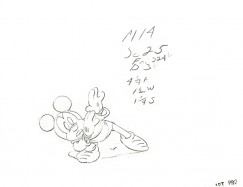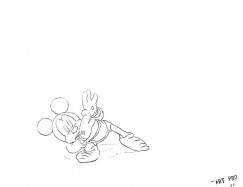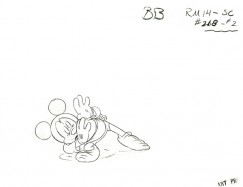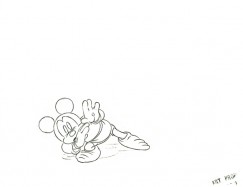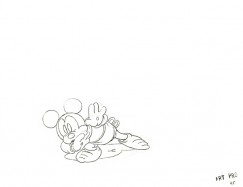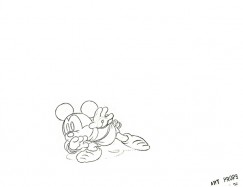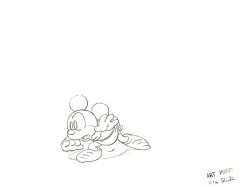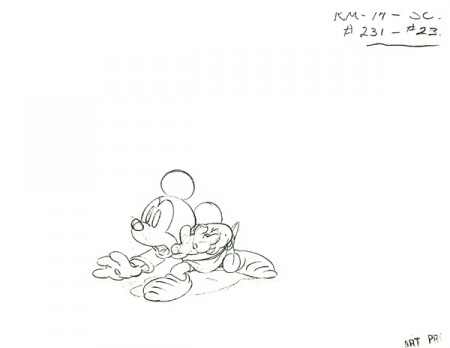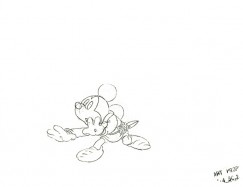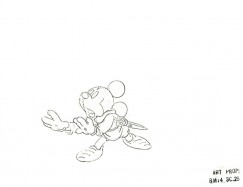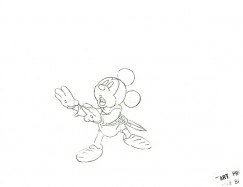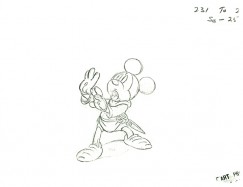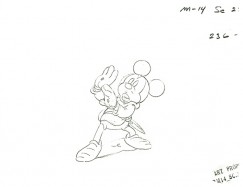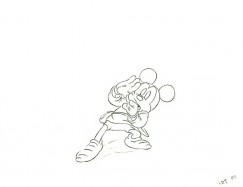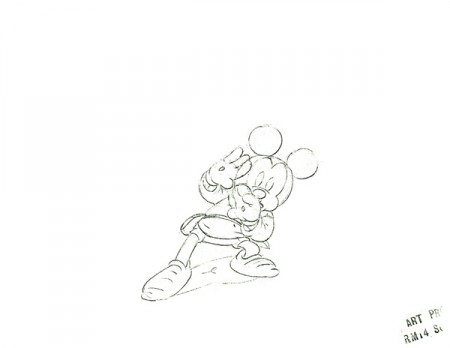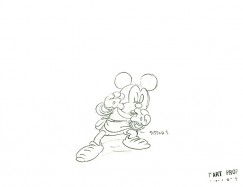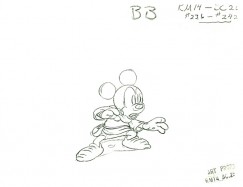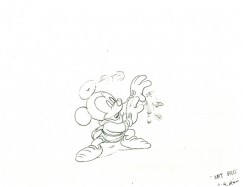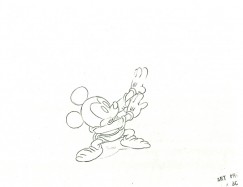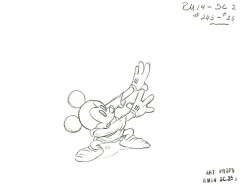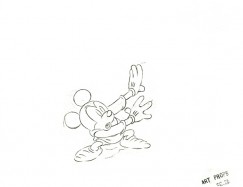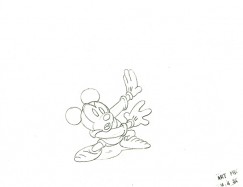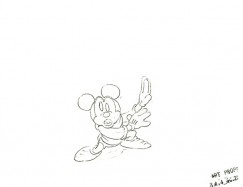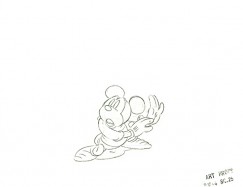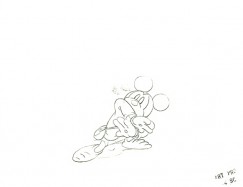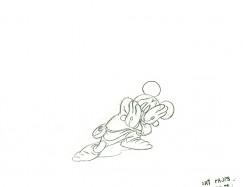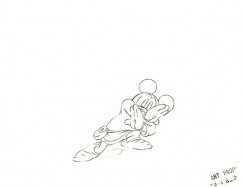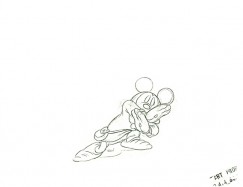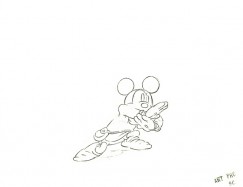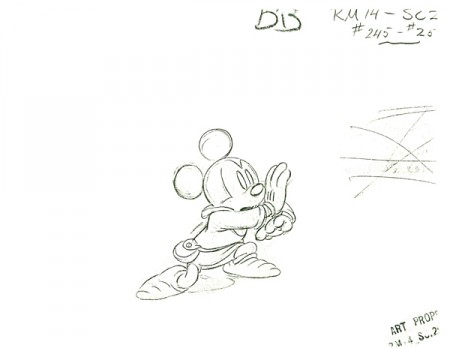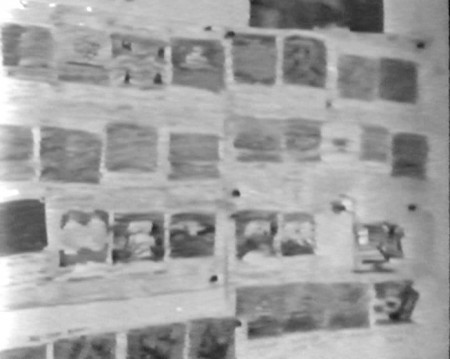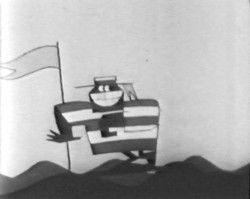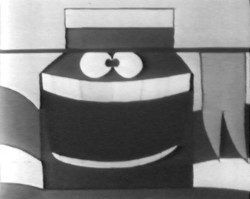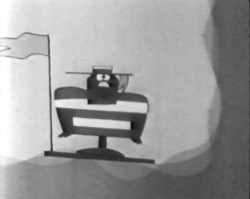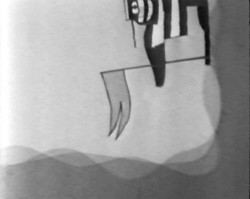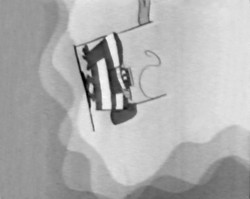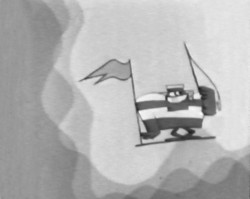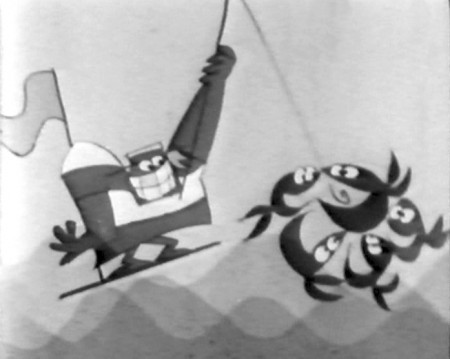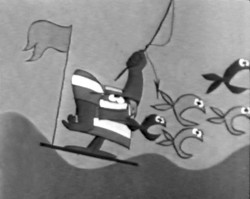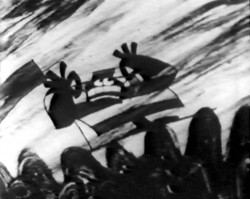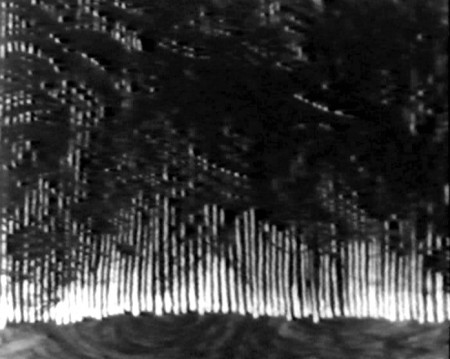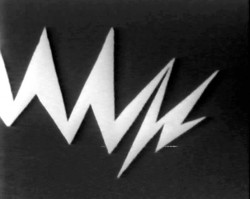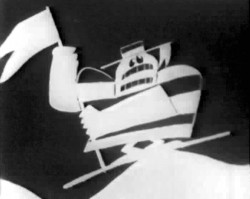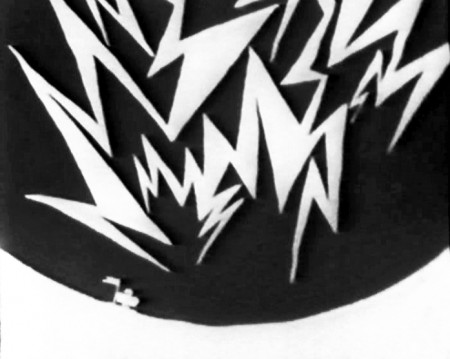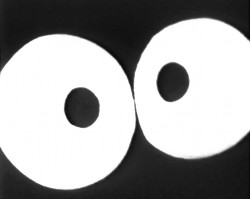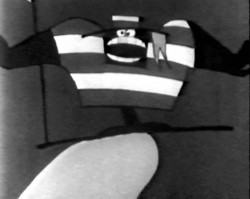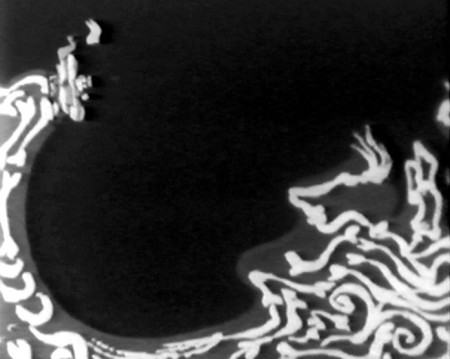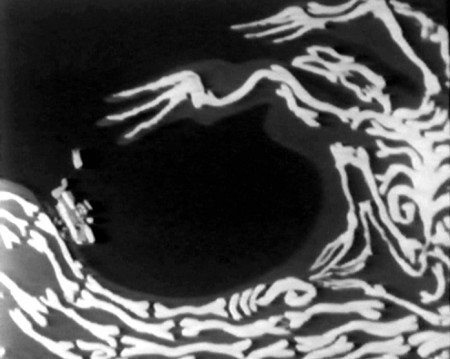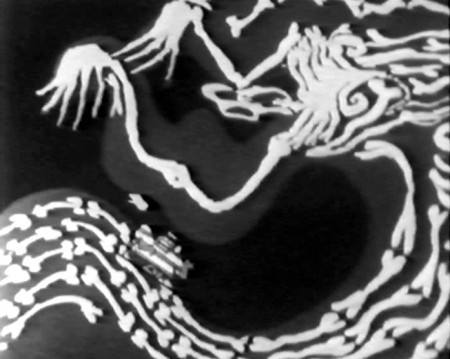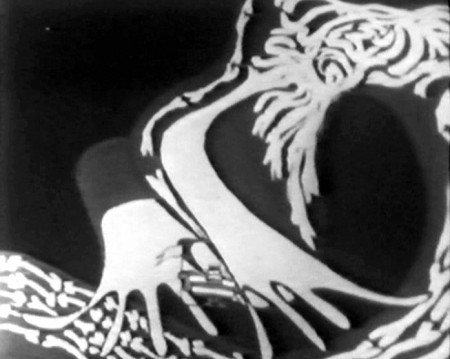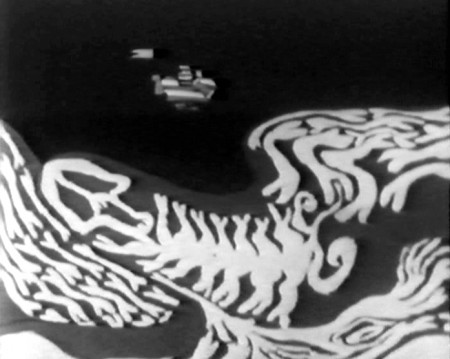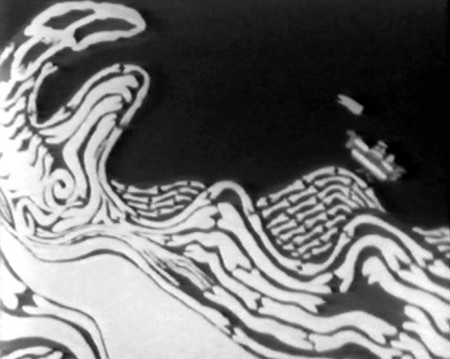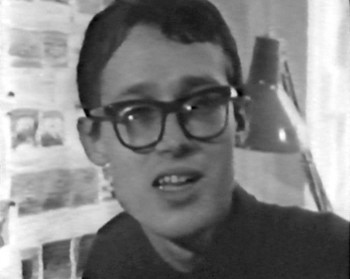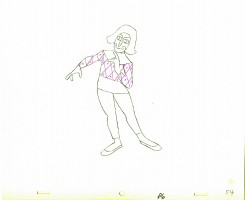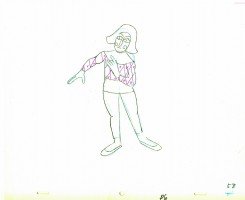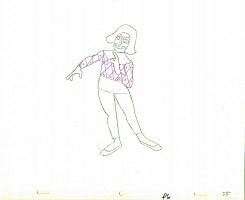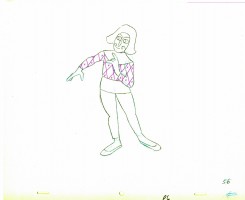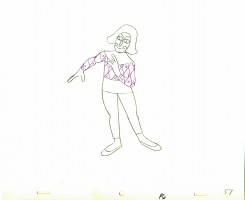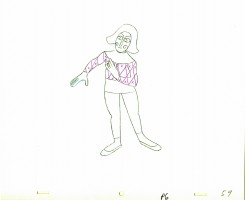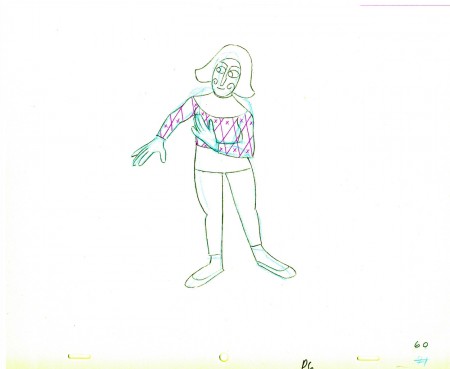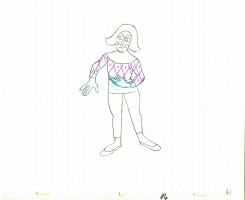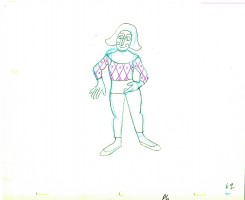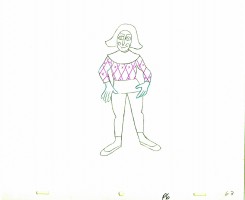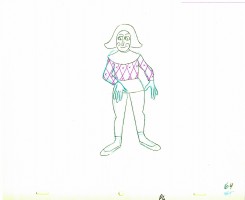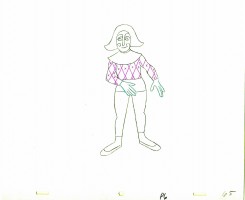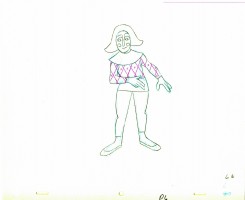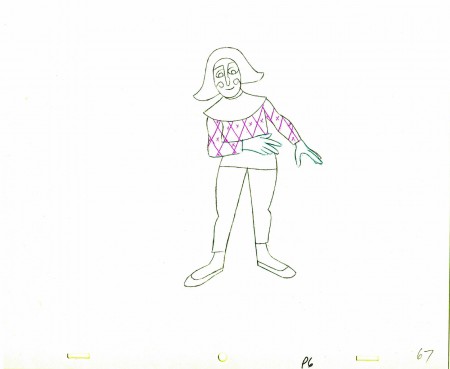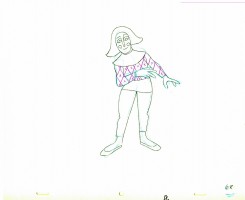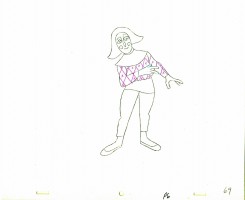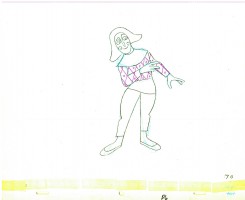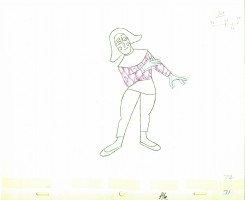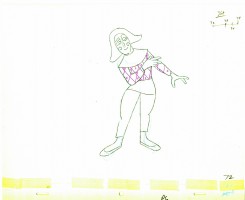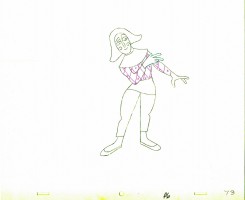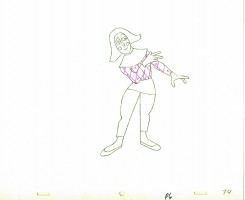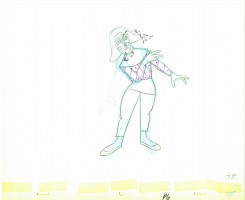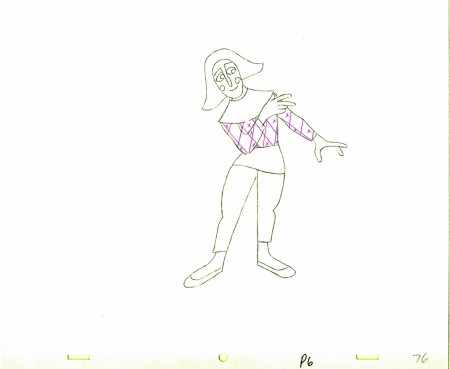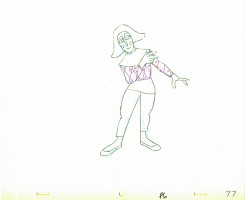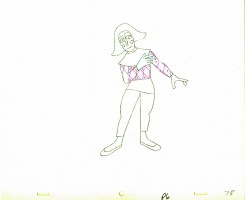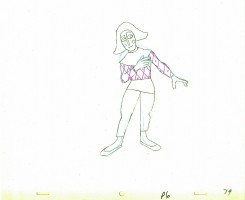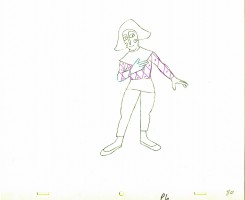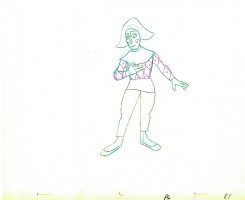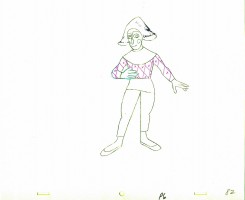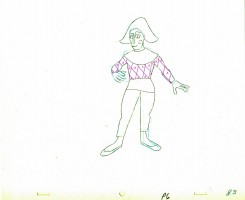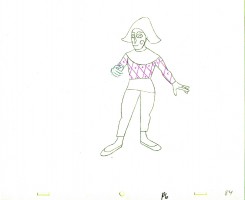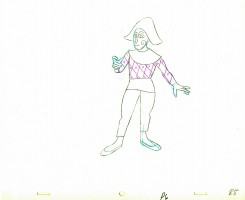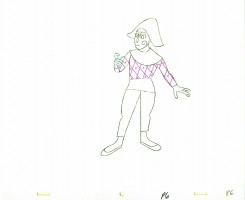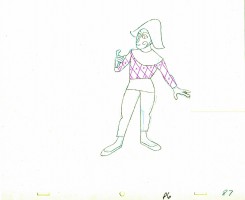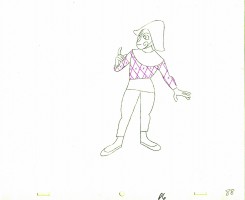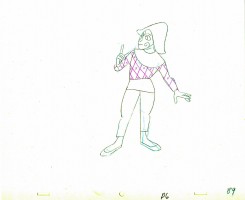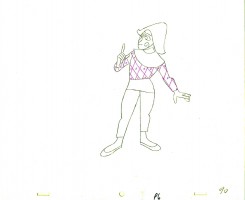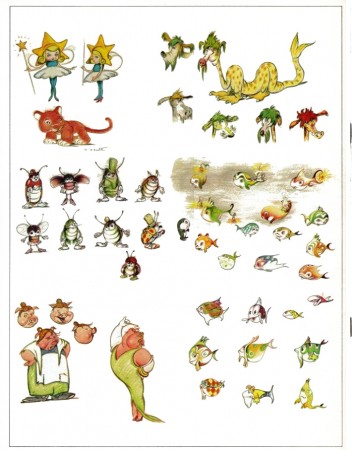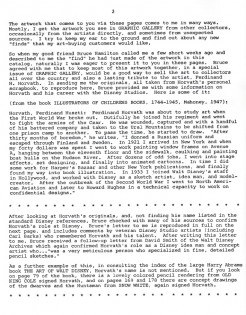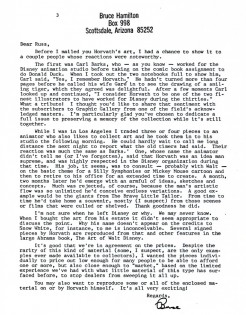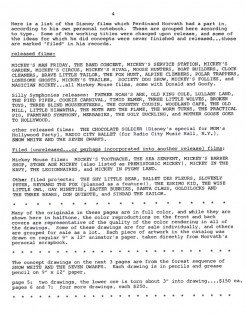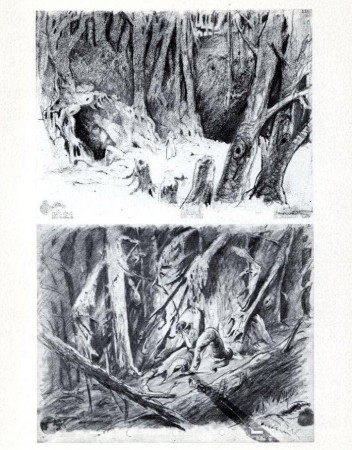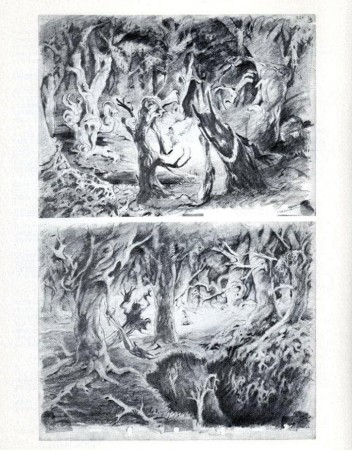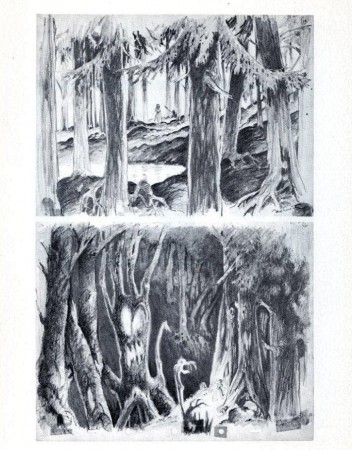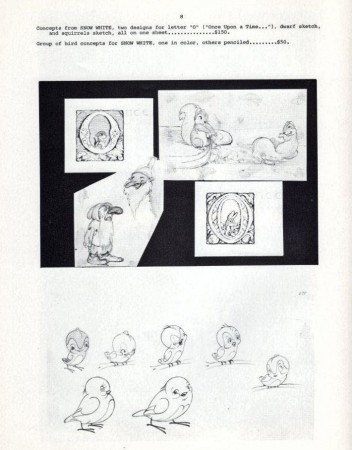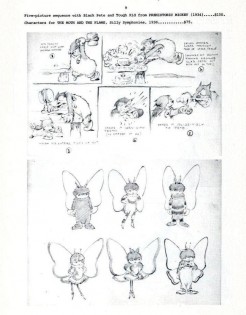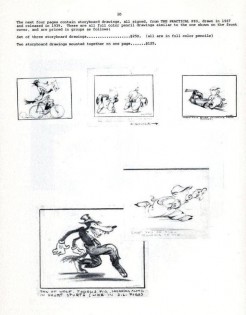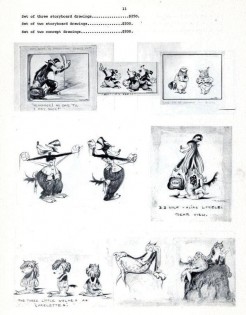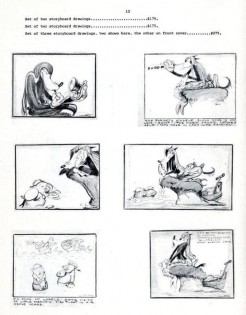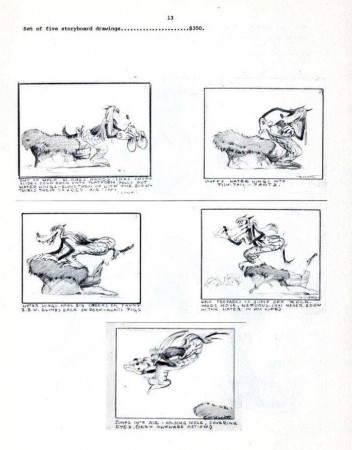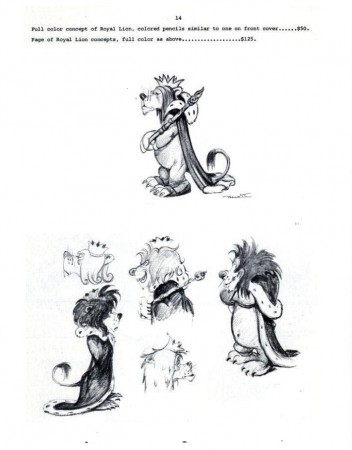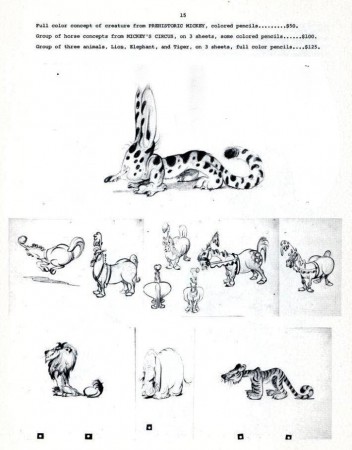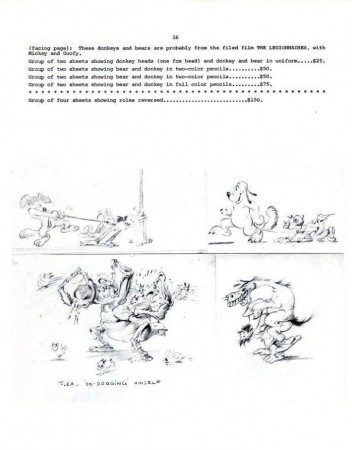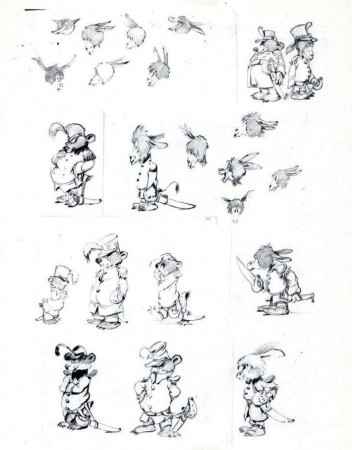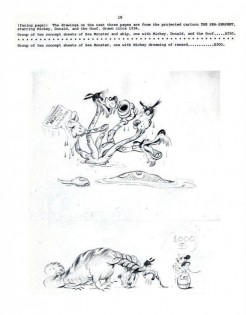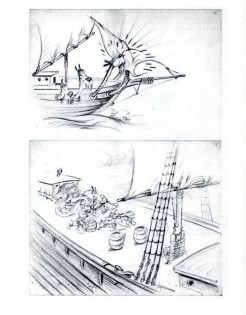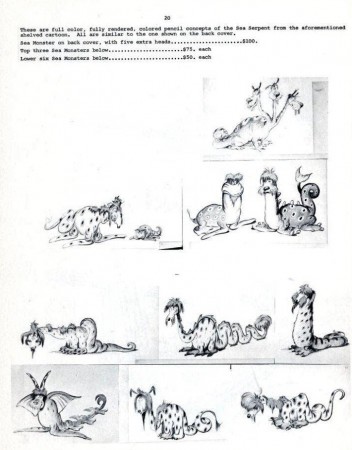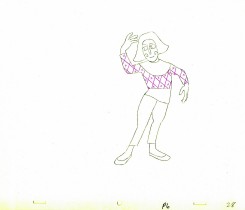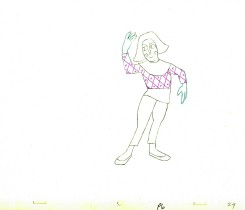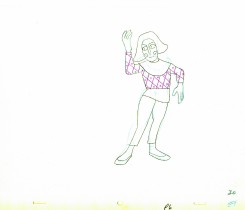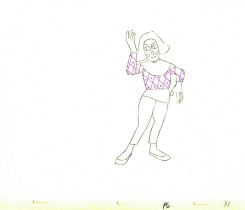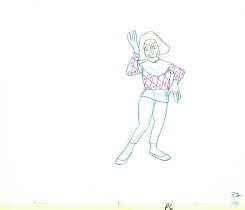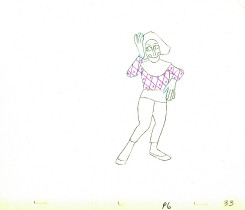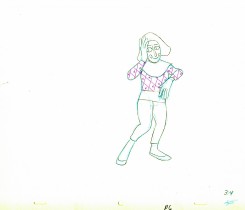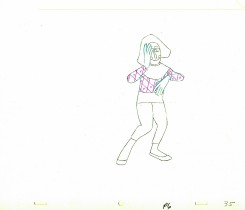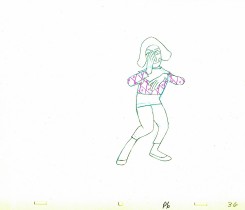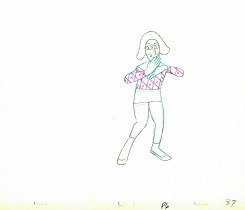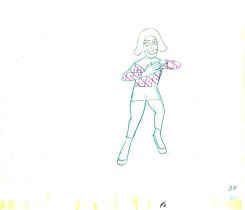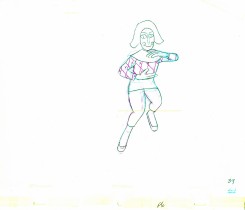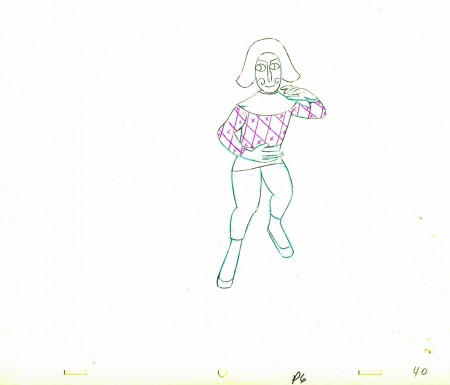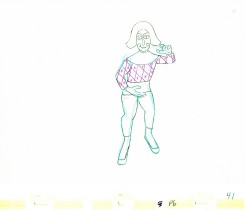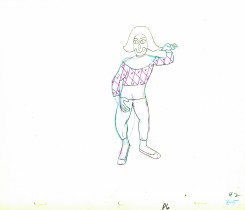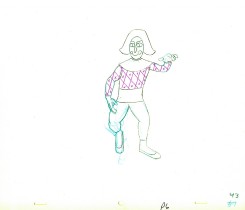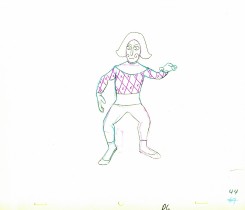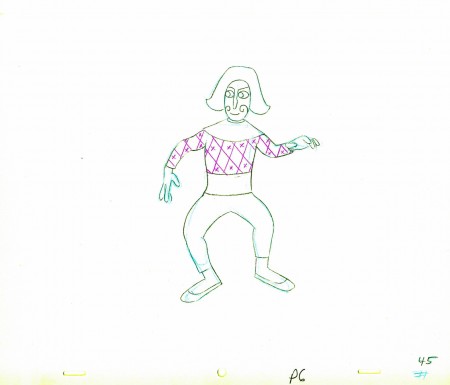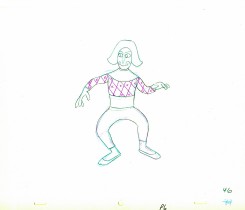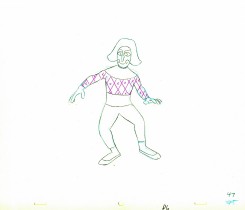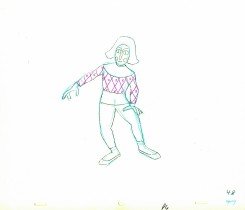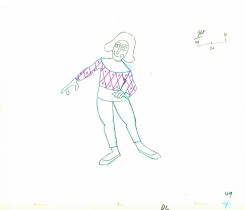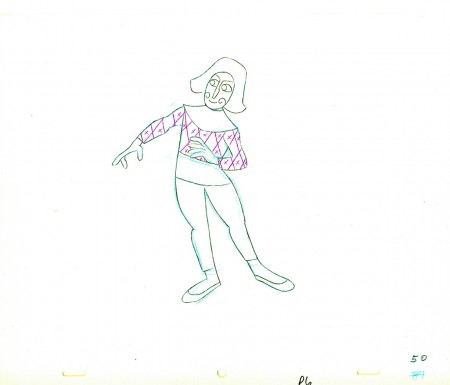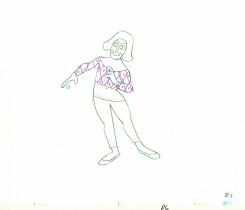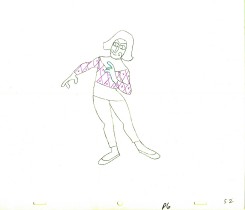Category ArchiveAnimation
Animation &Animation Artifacts &Hubley &Independent Animation 15 Sep 2010 07:49 am
Babbitt’s Carousel Mime – 5
- The Hubley feature film, Everybody Rides the Carousel, was adapted from Erik Erikson‘s Eight Stages of Man, a Psychosocial Theory of Human Development.
The Hubley conceit was to make the 8 stages of life as a carousel with 8 horses representing those different stages. The narrator was a mime and was animated, at first, by Art Babbitt, with Dave Palmer as his personal assistant. After animating a couple of early scenes, Babbitt left annoyed. Barrie Nelson completed the character in the show.
For the full story behind the rift between Hubley and Babbitt go to this past post.
The scene is 152 drawings long. This is the final section as the mime comes to rest. It’s a very slow moving character with short quick spurts of movement.
We begin with the last drawing from last week, #123.
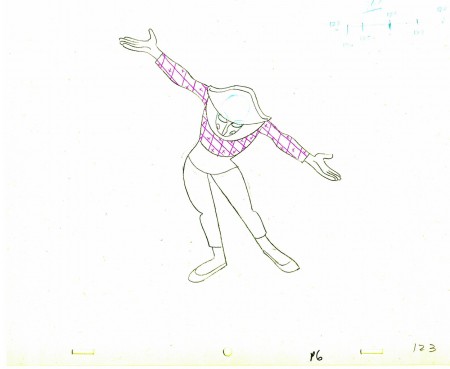 123
123(Click any image to enlarge.) ______________________
The following QT movie represents the drawings above
exposed as Babbitt wanted them, on twos.
Right side to watch single frame.
Animation &Frame Grabs &Independent Animation 12 Sep 2010 07:50 am
Bill Plympton talks Idiots & Angels
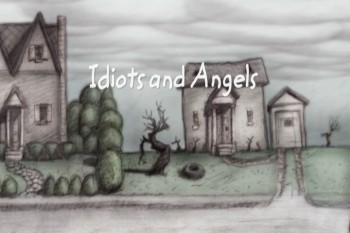 - Opening on October 6th at the IFC Film Center is Bill Plympton‘s most recent animated feature, Idiots and Angels. This like Bill’s other animated features is a labor of love; how could it be anything else when a small group works to produce 90 minutes of animation.
- Opening on October 6th at the IFC Film Center is Bill Plympton‘s most recent animated feature, Idiots and Angels. This like Bill’s other animated features is a labor of love; how could it be anything else when a small group works to produce 90 minutes of animation.
Bill’s style for this film has grown a bit darker and the subject is more cohesive for a full-length story. The look is more dark Eastern European than bright-cheery American. This makes it very grraphic and very much in the heart of Bill’s style.
I had the opportunity of interviewing him and asking 10 questions which illuminate a lot behind the process:
Michael Sporn: The story is probably your most complicated for a feature. The lead character is a bitter and nasty person (the “Idiot” of the title) whose wings (the “Angel”) take over his body to reveal his better nature. Where did this idea come from and what encouraged you to develop it?
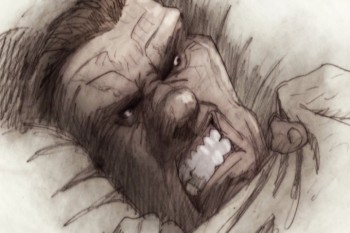 Bill Plympton: The idea for “Idiots and Angels” first came to me when I was in an animation festival in Lille, France and after screening “Hair High”, this French guy asked me what my next film would be—and off the top of my head, (I don’t know where it came from) I said “It’s a story about an asshole guy who wakes up one morning with tiny wings growing out of his back and he doesn’t like it because they make him do good things.”
Bill Plympton: The idea for “Idiots and Angels” first came to me when I was in an animation festival in Lille, France and after screening “Hair High”, this French guy asked me what my next film would be—and off the top of my head, (I don’t know where it came from) I said “It’s a story about an asshole guy who wakes up one morning with tiny wings growing out of his back and he doesn’t like it because they make him do good things.”
The kid said he liked the idea, and as I thought about it, so did I. In fact, that night as I lay in my hotel bed, I began to create the character, his environment, and little story sequences.
People say this is my most mature film. It talks about morality, spirituality, and the human soul—they say Bill Plympton is growing up. I hope not, because I will always want to make weird, surreal, offensive comedies.
MS: The draftsmanship in this film is probably your finest. There’s a lot of rendering on the characters using a limited number of colors. It’s perfectly tuned to the film. I wonder how all that line work and rendering is done. You animate the entire film yourself, but surely you must have a lot of help with the rendering? Do you do extremes to set the style and have others follow through?
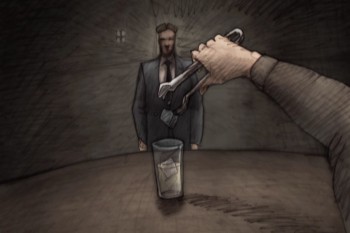 BP: The technique for this film is very new for me. All my other films were shot on a camera stand and now that the cost of digital to film transfer has come down to my pocketbook level, I’m able to scan the drawings and shade/color them digitally.
BP: The technique for this film is very new for me. All my other films were shot on a camera stand and now that the cost of digital to film transfer has come down to my pocketbook level, I’m able to scan the drawings and shade/color them digitally.
This is a great breakthrough for me, because all through my life I loved the simple look of pencil on paper. But when I began animation, my copier could never recreate the subtlety and richness of my pencil shaded drawings. So “Idiots and Angels” is the first film to properly recreate the pencil on paper look I love so much.
The process is fairly simple—I do all the animated drawings, erasing the mistakes and redrawing over the original, which gives the art a wonderful layered texure. Then I placed the humongous stack of scenes (30,000 drawings) on my co-producer Biljana Labovic’s desk and she makes sure the artwork is scanned, cleaned, composited, and most importantly colored to the noir-ish style of the concept drawings. We had a staff of about 25 people who off and on would come in to put my drawings together.
MS: – There is a lot of repetitive action in the film. That’s a major part of its style. (The repeated opening of the sunrise, clock and bird singing is obviously done over and over in many different ways.) Yet you don’t seem to use a lot of reuse in doing so. This would have been an easy option given the material. Was it a conscious choice to not do a lot of reuse?
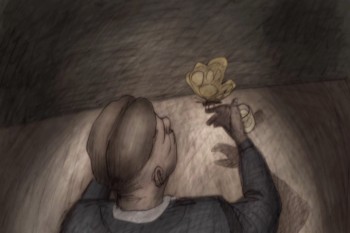 BP: Over the years I’ve had a lot of criticism because my films are not fully animated. In fact, the action is fairly herky-jerky. So in this film, I tried to smooth out the action somewhat. Instead of shooting on 3′s and 4′s I shot on 2′s and 3′s. Also, I wanted to put in the extra effort to try to use different shots for scenes that were repeated, just to give it a more professional look.
BP: Over the years I’ve had a lot of criticism because my films are not fully animated. In fact, the action is fairly herky-jerky. So in this film, I tried to smooth out the action somewhat. Instead of shooting on 3′s and 4′s I shot on 2′s and 3′s. Also, I wanted to put in the extra effort to try to use different shots for scenes that were repeated, just to give it a more professional look.
However, there’s one shot where Angel attempts suicide, and I held one drawing for approximately 30 seconds and let Greg Sextro, my sound man, tell the story only through sound effects. I always love it when I can take a shortcut like that and it makes the storytelling that much more unique and interesting.
MS: Having a small independent studio involves doing a lot of jobs that don’t pertain to the actual drawing of the film. How do you travel to film festivals, teach classes within your studio, raise money for your employees’ salaries, figure out how to distribute your film and still have time to animate a feature single handedly?
BP: That’s a very good question. I’ll answer the questions in order—The travel to film festivals is fun but also is a very important part of the job. I use film festivals to make sales and spread the message of indie animation. I’ve stopped teaching the classes, because I want to devote more time to my films and teaching wears me out. The money raising is through sales of my films all over the world on TV, theatrical, DVD, and other media.
My distribution is pretty much by formula now since I have a group of buyers that consistently pay me for the rights to my films. And finally, I have time to single handedly animate my films because I don’t have a family, and I just plain love to draw.
MS: Digital production must have affected your films. Do you work with Photoshop and Aftereffects to get your work to screen? And are the drawings colored prior to scanning?
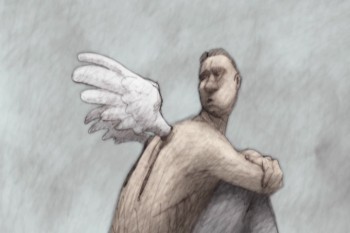 BP: The drawings are colored and shaded after they are scanned. My assistants use Photoshop to color the images, After Effects to composite the frames, and Final Cut Pro for editing and touch-up.
BP: The drawings are colored and shaded after they are scanned. My assistants use Photoshop to color the images, After Effects to composite the frames, and Final Cut Pro for editing and touch-up.
MS: Getting your films distributed has to be the hardest part of the work of feature production. Have you learned how to do it after so many features produced? Or does the business keep changing making it more difficult? Do you have any hope that a major distributor would step in to pick up the film, or do you plan to distribute it yourself?
BP: This is a very important question. There are three parts to filmmaking. 1) Raising the money, and this one is a very large barrier to many filmmakers. 2) Making the film – this is the fun part, and 3) Selling your film and actually making money off of it. This is by far the hardest part—maybe. 0.01% of filmmakers get past this barrier. To answer your question, fortunately, over the years, I’ve been able to create a name for myself and a large fan base.
So if by chance I don’t get a distribution deal I’m usually able to self-distribute, which is what I am doing with I&A. It’s a huge hassle because I have to make the deals with the cinemas, sign the contracts, make posters, make trailers, make multiple prints and do all the press. Then I have to get the money from the cinemas.
But the best part is that I get to retain ownership of the film and often times I make a lot more money than I would with a large distributor.
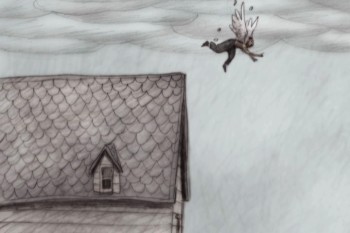 MS: I know that you’re prone to see everything that’s animated. Does the work of big companies, such as Disney, Pixar or Dreamworks affect the way you do your films in any way?
MS: I know that you’re prone to see everything that’s animated. Does the work of big companies, such as Disney, Pixar or Dreamworks affect the way you do your films in any way?
BP: I’m very happy with the success of Blue Sky, Pixar, and Dreamworks. We’re living in an exciting time when we’re seeing 20 or so animated feature films released every year. In the so-called “golden age” of animation 1930-1950, we’d be lucky to see one animated feature every two years.
I believe that the kids who grew up watching “Lion King” or “A Bug’s Life” now want to see animation with adult ideas done in more creative styles, and hopefully these are the people who will line up outside the IFC on October 6th to see “Idiots and Angels”.
MS: Since you’ve started making feature films, others have followed your suit in making their own long films. Does the competition worry you or are you open to it?
BP: In 1991 when I made “The Tune” independent features were a very rare specialty.
Now it seems, thanks to digital technology, that everyone is making their own animated feature and they’re great films: “Sita Sings the Blues”, “My Dog Tulip”, “Queer Duck”. I believe that we need to cultivate this audience for indie animation and show them that there’s some great amazing films being made by small groups of people without major funding!
MS: Do you have another feature in the works?
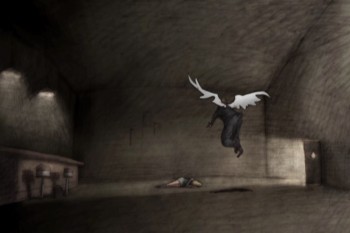 BP: Actually, I have two features I’m working on. One has the working title “Cheatin’” that’s done in a very similar style as “Idiots and Angels” but with a much more exaggerated visual style. I’ve put that on hold while I negotiate financing. In the mean time, I’m working on a flash feature called “Tiffany the Whale”. The script and storyboard are all done and we’re already begun animation. This will be a much lower budget film and may be serialized on the internet.
BP: Actually, I have two features I’m working on. One has the working title “Cheatin’” that’s done in a very similar style as “Idiots and Angels” but with a much more exaggerated visual style. I’ve put that on hold while I negotiate financing. In the mean time, I’m working on a flash feature called “Tiffany the Whale”. The script and storyboard are all done and we’re already begun animation. This will be a much lower budget film and may be serialized on the internet.
Finally Michael, I want to thank you for giving me an opportunity to talk about my films and hopefully make people aware of the thriving indie animation scene. You’ve been an inspiration for me my whole career so it means a lot to me that you’ve give me your support.
MS: I’m always open and available to you, Bill. You’re the insiration for most Independent animators, believe me. How could I not support that!
Animation &Hubley &Independent Animation 08 Sep 2010 07:43 am
Babbitt’s Carousel Mime – 4
- John Hubley‘s feature film, Everybody Rides the Carousel, was adapted from Erik Erikson‘s Eight Stages of Man, a Psychosocial Theory of Human Development.
There was a carousel with 8 horses representing different stages of life. The narrator, a mime, was animated by Art Babbitt, with Dave Palmer as his personal assistant. After animating a couple of early scenes, Babbitt left annoyed. Barrie Nelson completed the character in the show.
For the full story behind the rift between Hubley and Babbitt go to this past post.
The scene is about 200 drawings long. Here’s the fourth part. It’s a very slow moving character with short quick spurts of movement.
We begin with the last drawing from last week.
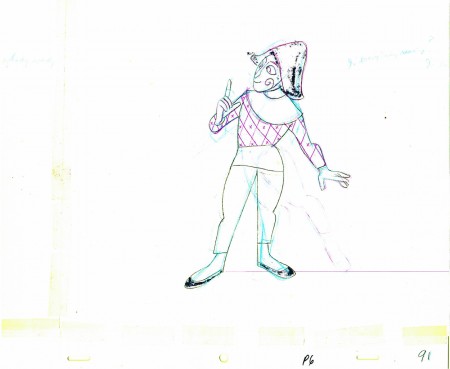 91
______________________
91
______________________
The following QT movie represents the drawings above
exposed as Babbitt wanted them, on twos.
Right side to watch single frame.
Animation &Animation Artifacts &Disney 06 Sep 2010 08:16 am
Recap – Thomas’ Little Tailor -4
- Hans Perk reminded me that yesterday was the birthday of the late Frank Thomas. To celebrate: Rather than post my usual Mary Blair piece (which I’ll post tomorrow), I thought I’d recap this last part of Thomas’ Brave Little Tailor scene. You can link to earlier parts if you like. The scene is a masterpiece and possibly my favorite Thomas scene of all time.
- So, finally, we’ve reached the end of this magnificent Frank Thomas scene from The Brave Little Tailor. The other three parts can be found here: Part 1, Part 2, & Part 3.
Many thanks to friend, Lou Scarborough for the loan of the xerox copies so I could post the scene.
We start with the last drawing from Part 3.
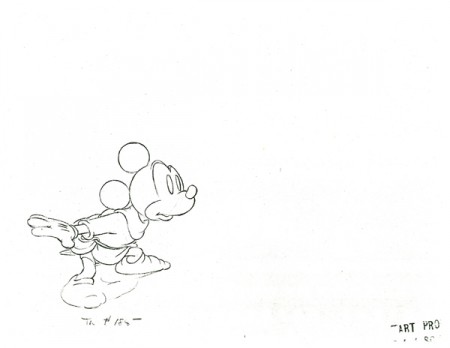 183
183(Click any image to enlarge.)
The following QT movie represents all 246 drawings of the scene.
Click left side of the black bar to play.Right side to watch single frame.
Animation &Errol Le Cain &Independent Animation &Richard Williams 04 Sep 2010 07:35 am
The Sailor & the Devil
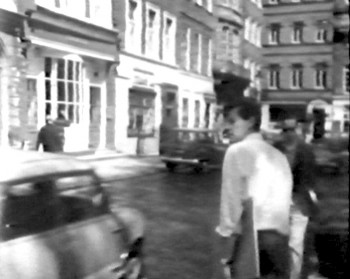 - There was a documentary about Richard Williams that I saw many years ago on PBS. It made me an ardent enthusiast of Williams’ work, and I followed his trajectory over many years. Eventually, I worked with him.
- There was a documentary about Richard Williams that I saw many years ago on PBS. It made me an ardent enthusiast of Williams’ work, and I followed his trajectory over many years. Eventually, I worked with him.
The show was called The Creative Person: Richard Williams and was made in 1966. Within the show was a very small section about one of Williams’ artists, Errol LeCain. He was given the task of making a film 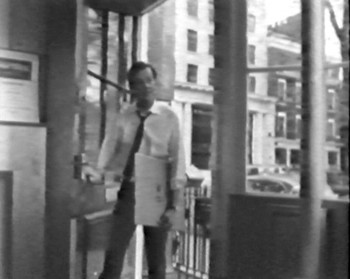 by himself. As Williams explains, this would teach him all the aspects of animation filmmaking and the studio would gain a short film in the end.
by himself. As Williams explains, this would teach him all the aspects of animation filmmaking and the studio would gain a short film in the end.
The film was called The Sailor and the Devil. This is probably the only film done by the Williams Studio that I haven’t seen. It’s still not on YouTube. Hans Bacher gave some color images on his site, one1more2time3, a year ago. Wanting more, I went back to the special and made frame grabs of some of the film, and I’m posting them here.
Dick was so young, as was Errol LeCain. He went on, of course, to become a world-class children’s book illustrator and the original designer of the backgrounds for the ill-fated Cobbler and the Thief.
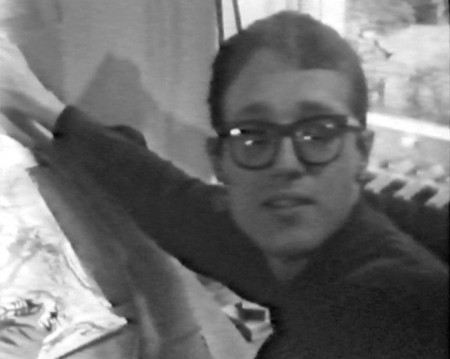
Errol LeCain
Animation &Animation Artifacts &Hubley &Independent Animation 02 Sep 2010 07:32 am
Babbitt’s Carousel Mime – 3
- John Hubley‘s feature film, Everybody Rides the Carousel, was adapted from Erik Erikson’s Eight Stages of Man, a Psychosocial Theory of Human Development.
The feature was built around a carousel. 8 horses represented different stages of life. The narrator, a mime, was animated by Art Babbitt, with Dave Palmer as his personal assistant. He left after animating a couple of early scenes. Barrie Nelson completed the character in the show.
For the full story behind the rift between Hubley and Babbitt go to this past post.
The scene is about 200 drawings long. Here’s the third part. It’s a very slow moving character with short quick spurts of movement.
We begin with the last drawing from last week.
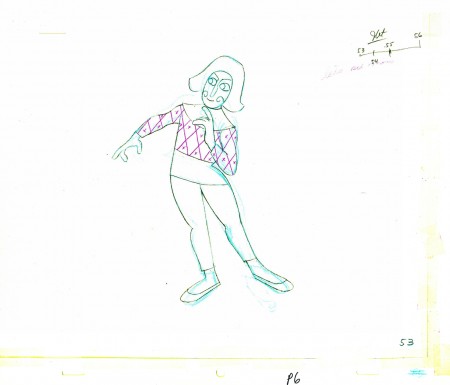 53
53(Click any image to enlarge.) ______________________
The following QT movie represents the drawings above
exposed as Babbitt wanted them, on twos.
Right side to watch single frame.
Animation &Bill Peckmann &Books &Disney &Illustration &Layout & Design &Models 01 Sep 2010 07:38 am
Horvath – 1
Ferdinand Horvath was a Hungarian book illustrator, who was born in 1891 and died of a stroke in 1973. From 1934-1937, he worked at the Disney Studios in multifarious positions doing everything from painting backgrounds and doing layouts to constructing three dimensional models to designing characters and gags for over fifty Silly Symphonies and Mickey Mouse shorts.
Prior to working at Disney, he labored at Paul Terry’s studio on the “Aesop’s Fables” series. Once he left Disney, he designed models and layouts for “Scrappy,” “Krazy Kat” on shorts for Columbia/Screen Gems. In 1940, he sculpted puppets for George Pal’s Puppetoons.
He was a versatile artist whose work was an inspiration for many Disney artists. The following booklet was published by Graphis Gallery and put together by Bruce Hamilton. The opening material explains itself.
Bill Peckmann sent me scans of these pages, and I thank him for keeping Horvath alive.
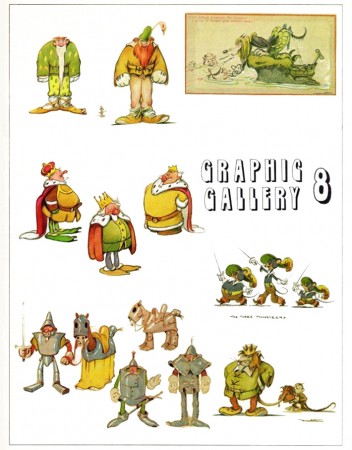
Front cover of the catalogue.
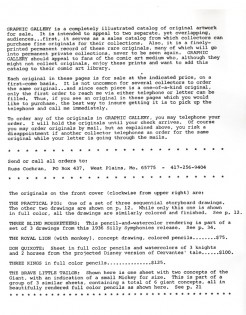 1
1 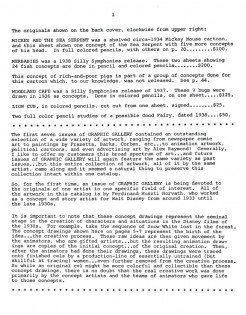 2
2
This gives information on what appears on the two covers.
.
John Canemaker writes in depth about Horvath in his book, Before the Animation Begins: The Art and Lives of Disney’s Inspirational Sketch Artists.
Animation &Puppet Animation 28 Aug 2010 07:45 am
Kihachiro Kawamoto
- This last week saw the death of two Japanese animation masters. The very young (46) 2D director, Satoshi Kon, died of pancreatic cancer on Tuesday.
Then we learned that the brilliant puppet animator, Kihachiro Kawamoto had died on Monday. (Cartoon Brew has an excellent obituary for him.)
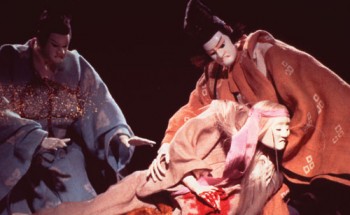 He was an acolyte of Jiri Trnka‘s, having travelled to Czechoslovakia to work with the great puppet filmmaker. Kawamoto’s own short films were gem-like little jewels which often told harrowing Japanese folk tales. Films such as The Demon (1972), Dojoji Temple (1976) and House of Flame (1979) are pure film yet they retain the spirituality of old Japanese mysticism.
He was an acolyte of Jiri Trnka‘s, having travelled to Czechoslovakia to work with the great puppet filmmaker. Kawamoto’s own short films were gem-like little jewels which often told harrowing Japanese folk tales. Films such as The Demon (1972), Dojoji Temple (1976) and House of Flame (1979) are pure film yet they retain the spirituality of old Japanese mysticism.
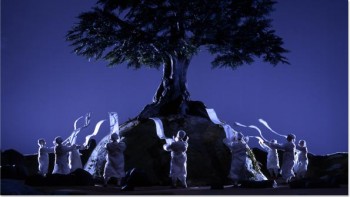 Aside from the numerous beautiful short films he animated and directed, he did two features: The Book of the Dead and Rennyo and His Mother. He also supervised the cut out feature, Winter Days, a film inspired by the renka couplets of celebrated haiku poet Matsuo Basho. 35 of the world’s top animators created two-minute segments for the film. The most popular of these was Yuri Norstein
Aside from the numerous beautiful short films he animated and directed, he did two features: The Book of the Dead and Rennyo and His Mother. He also supervised the cut out feature, Winter Days, a film inspired by the renka couplets of celebrated haiku poet Matsuo Basho. 35 of the world’s top animators created two-minute segments for the film. The most popular of these was Yuri Norstein
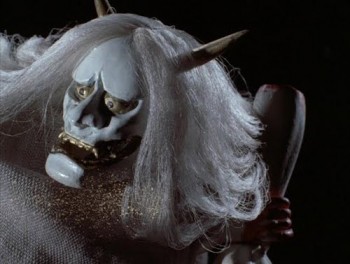 Again I saw him in Ottawa in 2006 at an animation festival. His feature, The Book of the Dead, was being screened. He spoke to an audience at a Q&A for the filmmakers. It wasn’t quite the same feel meeting him this time, but it was more relaxed and a treat, all the same.
Again I saw him in Ottawa in 2006 at an animation festival. His feature, The Book of the Dead, was being screened. He spoke to an audience at a Q&A for the filmmakers. It wasn’t quite the same feel meeting him this time, but it was more relaxed and a treat, all the same.
He died of complications from pneumonia on Monday, August 23 at the age of 85. He was a brilliant puppet filmmaker – one of the very best.
Animation &Daily post &Disney 26 Aug 2010 08:04 am
Kon/Mickey/Indep’ts/Day&Night
- I have to take note of the passing of Satoshi Kon. There’s a short piece via Charles Solomon, about him on Cartoon Brew, which I suggest you read. The links there brought me to this piece with more information. He died abruptly of pancreatic cancer. His diagnosis on May 18th was that he would have at most 6 months to live. He died August 24th at the age of 46.
There’s an excelelent obit in today’s NYTimes by A.O. Scott.
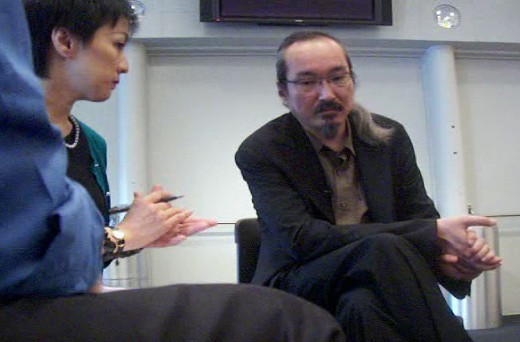
L to R: Me, the interpreter and Mr. Kon
I had the pleasure of interviewing him back in June, 2009. Unfortunately the recording of the interpreter, who spoke so softly, was not good, and I couldn’t get much of a transcript. He was polite, positive and a pleasure to meet, even though a great deal didn’t come of the conversation. His art around the room was stunning. I am decidedly a fan of his work. He died Tuesday, a terribly sad end.
You can see some of this art in the blog post I wrote that day. Go here.
Richard O’Connor also wrote a short, nice pieco on his blog, Asterisk Animation
You should also check out his films Millenium Actress, Tokyo Godfathers, and Paprika.
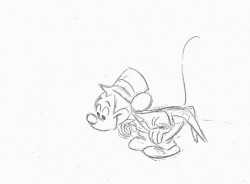 - Back in February 2007, Hans Perk offered the storyboard and some notes on the shelved Mickey Mouse cartoon, The Plight of the Bumblebee. This was on his site A FIlm LA. It was animated by Fred Moore, Hal King and Cliff Nordberg and was shelved partially because of length. Jack Kinney, the director, calls it the best Mickey film (though it’s definitely not despite the generally fluid yet unispired animation.)
- Back in February 2007, Hans Perk offered the storyboard and some notes on the shelved Mickey Mouse cartoon, The Plight of the Bumblebee. This was on his site A FIlm LA. It was animated by Fred Moore, Hal King and Cliff Nordberg and was shelved partially because of length. Jack Kinney, the director, calls it the best Mickey film (though it’s definitely not despite the generally fluid yet unispired animation.)
This is important because Thad Komorowski offers the entire pencil test of the film on his site.
Hans suggests that Mr. Lasseter call down to order the film completed since it’s already so close. Nothing happening since that was written in 2007. I’d guess that Lasseter won’t take notice.
Anyway, this is great payoff. Thanks Hans and Thad.
.
- John Canemaker‘s column about Charles Burchfield receives an excellent comment from Richard O’Connor on the Asterisk Animation blog. The connection is made to the new show of Burchfield’s work at the Whitney Museum of Art. Richard’s article is worth a read, and John’s article is, obviously, also worth reading.
.
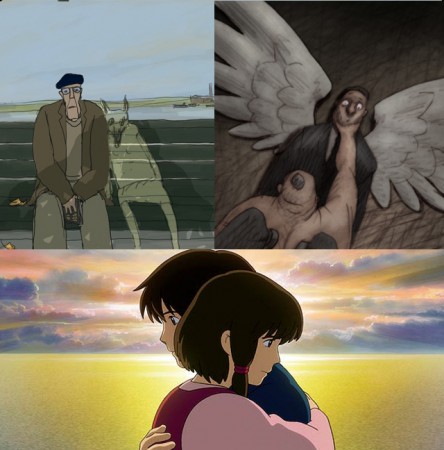
- I’d like to remind those in New York that there are three features on the horizon (or in one case, already here), about to play in theaters.
Paul and Sandra Fierlinger‘s film, My Dog Tulip, starts at the Film Forum next week, September 1st. For this film, we’ll feature three separate reviews by the animation staff (that includes me, of course, as well as Matt Clinton and Katrina Gregorius) here at the studio. We’ll probably post it on Tuesday, a day before the opening.
Bill Plympton has his feature, Idiots and Angels, opening at the IFC Center on Oct 6th. I intend to offer an interview with Bill before the film opens, so you can look forward to that. The film has played at many Festivals, so there’s been ample chance for enthusiastic animators to get a preview. If you haven’t seen it the chance will now be there.
Currently playing at the Angelicka is the feature Tales from Earthsea. This was directed by Goro Miyazaki, the son of Hayao Miyazaki. Goro was chosen as a potential way of handing down the father’s directoral mantle when Hayao was planning to retire. When Hayao saw the final of Tales from Earthsea, the father decided not to retire. Instead he made one of his best features with last year’s US release, Ponyo. He’s currently doing another two features. He and his son didn’t speak during the making of the film.
The best review I read of this film is, naturally, on The Ghibli Blog by Daniel Thomas MacInnes.
There’s also a good interview with the book’s author Ursula Le Guin.
- A small footnote. Disney has decided to withdraw its animated product from the Annie Awards. That’s right Toy Story 3 and Day & Night will not be competing for Annie Awards this year.
The people at Disney/Pixar feel that anyone can join ASIFA and vote for the awards. They don’t say that they haven’t won against the Dreamworks product for the last few years. Rotten Tomatoes, indeed.
Here’s the Variety story, if you can’t get it without a subscription.
.
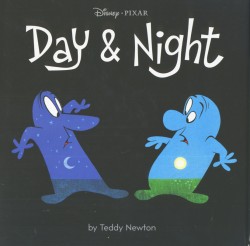 Speaking of Day & Night, I received a copy of the book which sells for only $10 at Amazon.
Speaking of Day & Night, I received a copy of the book which sells for only $10 at Amazon.
The book is better than the short film – it takes less time to read. The graphics are better; it’s not a melange of hand drawn work and cgi inner-body motion. The cg is replaced with watercolors. The artwork by author/illustrator Teddy Newton is more constant than the film and decidedly better.
The story – it’s the same sophmoric tale. However, you don’t have to listen to the ending’s narrator telling us what we already know. I doubt I’d ever have bought this book, but thanks the excellent publisher, Chronicle Books, I now own it. This publisher always does a good job with their product.
Animation &Animation Artifacts &Hubley 25 Aug 2010 05:52 am
Babbitt’s Carousel Mime – 2
- John Hubley‘s feature film, Everybody Rides the Carousel, was adapted from Erik Erikson’s book, Eight Stages of Man, a Psychosocial Theory of Human Development.
The feature was built around a carousel. 8 horses represented different stages of life. The narrator, a mime, was animated by Art Babbitt, with Dave Palmer as his personal assistant. He left after animating a couple of early scenes. Barrie Nelson completed the character in the show.
For the full story behind the rift between Hubley and Babbitt go to this past post.
The scene is about 200 drawings long. Here’s the second part. It’s a very slow moving character with short quick spurts of movement.
We begin with the last drawing from last week.
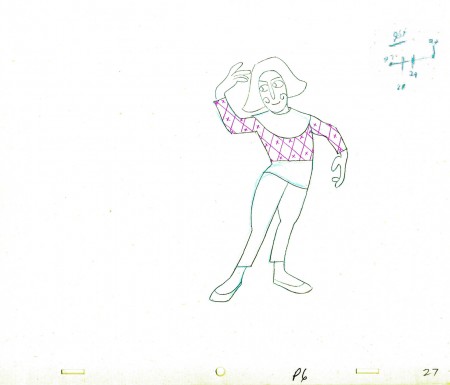 27
______________________
27
______________________
The following QT movie represents the drawings above
exposed as Babbitt wanted them, on twos.
Right side to watch single frame.
/font>
